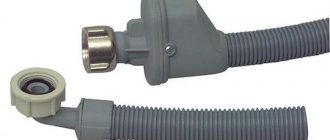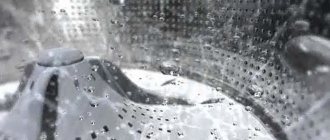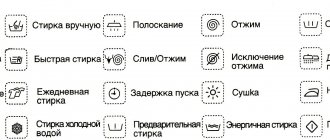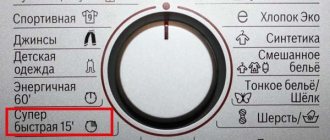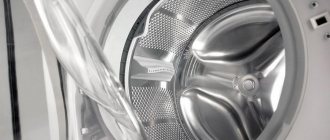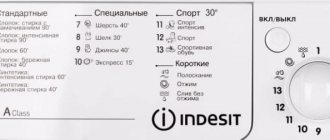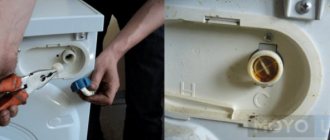26 Aug 2021
7499
Inverter motors, compared to brush-commutator motors, are quieter, last many times longer and consume less electricity. They come in two types: belt driven and direct driven, that is, they are attached directly to the drum of the washing machine. The warranty for the first type of inverters from Haier is 12 years, for the second type it is unlimited.
- Motor in a washing machine
- Pros and cons of an inverter motor
- Types of inverter motors
- Comparison of an inverter with a conventional motor
- How to care for your inverter
- Myths about inverter motors
- What is important when choosing a washing machine
Motor in a washing machine
The washing machine, regardless of the type of loading (frontal or horizontal), works on the same principle: the drum, together with the clothes, rotates in a layer of water and foam from the washing powder. Depending on the program, the drum rotates at different speeds (both in one direction and the other, periodically changing direction) and reaches maximum speed during spinning. The difference in how the drum is driven, how accurately it changes speed and how many revolutions per minute it can reach is made by the engine.
There are many types of electric motors: single-phase, three-phase, synchronous, asynchronous, with mechanical and electronic commutation, direct and alternating current and others. It is enough to remember that each of them has two key components: the stator (stationary part) and the rotor (rotating part). In washing machines (and household appliances in general), three types of motors are usually used:
- Collector (or brush, because special brushes - carbon contacts - are responsible for the electrical connection of the stator and rotor elements).
- Asynchronous (brushless, the rotor rotation speed does not coincide with the rotation frequency of the magnetic field created by the stator - it is either less at the time of acceleration, or more during the period of active operation).
- Inverter (also brushless, similar in principle to asynchronous, but the rotor is driven not by a magnetized armature, but by an inverter - a voltage converter).
In simple words, the inverter allows you to change the alternating current voltage from a 220 volt outlet to a range from 0 to 120 volts, and this is direct current.
Due to this, the inverter motor works more efficiently. The principle of operation of the inverter motor in a washing machine can be shown schematically. The picture shows that the inverter provides a smooth consumption of electricity, while other types of motors consume it spasmodically and inefficiently - they supply more voltage to raise the speed of the machine, reduce it when the speed of rotation of the drum needs to be reduced.
Comparison of the operation of two motors: conventional and inverter
Example: you have loaded 2 kg of laundry into the drum with a nominal capacity of 6 kg. If you have a brushed or induction motor, it will work at maximum power to spin the drum (as if there were 6 kg in it). The inverter will ensure more efficient operation of the engine without compromising the quality of the wash: it will supply as much voltage as is needed to spin the drum, taking into account 2, not 6, kg of clothes. The device will consume less electricity.
We begin diagnostics and repair of engines
Now let's talk in more detail about repairing the most common faults in electric motors of washing machines.
Diagnostics of electric motors
Correct diagnosis is half the work when repairing
Let's figure out how to diagnose electric motors when they break down. To do this, we need an ordinary multimeter - a device that almost every “homemade person with hands” has. The easiest to diagnose is the commutator motor, so if this is what is installed in your washing machine, you can easily do everything yourself.
So, the first thing we need to do is remove the motor from the washing machine. Here are step-by-step instructions on how to do it.
Removing the engine
- We disconnect the washing machine from the electrical network and move it to a free place so that we can freely approach it from any side.
- Remove the inspection hatch using a screwdriver or screwdriver. For side-loading machines, this is the rear panel, and for top-loading machines, it is the side panel. We unscrew all the screws and move the panel down.
- Next, you need to remove the belt - this is done very simply, just pull it towards you where it fits onto the pulley (a large wheel connected to the drum), and turn it a little. If you've ever changed a chain on a bicycle, the principle will be intuitive to you.
- Then remove the power and ground terminals from the motor.
Bosch 1200 washing machine and electric motor repair
- Now you need to unscrew the bolts that hold the engine. It is most convenient to use a spanner wrench for these purposes.
- All that remains is to remove the engine. It is supported by straight heels, so it needs to be lowered a little and pushed forward, and sometimes considerable effort is required. You can try lightly tapping with a hammer, but it is better not to disturb the engine and remove it with smooth rocking movements.
After the motor is removed, you need to test run it. To do this, we connect the rotor and stator windings in series, and connect an alternating current source with a voltage of 220 V to the remaining connectors.
Attention! You also need to include some kind of heating element in the circuit, for example from a washing machine, or a powerful lamp of at least 500 W. This must be done in order to protect yourself in case a short circuit occurs in the engine. If there is a short circuit, the heating element will begin to sharply increase its temperature, and the lamp will burn brightly.
It would be better if it is possible to power the circuit using a car transformer with a power exceeding 500 W. This will allow you to more clearly control the speed of the running engine. For greater safety, you can include 5 or 10 Amp fuses in the circuit.
If the engine is rotating, then carefully look at the intensity of the sparking at the point of contact between the brushes and the commutator; if it is strong, then there is a high probability that the motor is faulty. Most often, the commutator lamellas, rotor and stator windings, and brushes become faulty.
Continuity testing of individual engine parts
Repairing a washing machine when the electric motor gets hot
If your engine was not producing full power and was making strange noises, and after a test run you determined that it was getting very hot, then the problem is most likely a faulty rotor or stator winding. You can check this using a multimeter, which must be switched to resistance measurement mode.
Continuity of the rotor winding
We successively touch the probes of the device to the adjacent rotor lamellas. Differences in measurements should not exceed 0.5 ohms, and their value should correspond to the data specified in the engine passport, if any. If significant differences are detected, then we can safely state a short circuit between the turns.
In some cases, such a malfunction can be determined tactilely and by smell. Due to the fact that lower resistance causes an increase in current strength, and as a result - overheating, individual lamellas may have a higher temperature than others. At the same time, you will feel a characteristic burning smell.
If during testing the resistance tends to infinity, then this indicates a break in one of the windings.
Continuity of the stator winding
Next you need to ring the stator. The procedure is similar to that described above. First, we measure the resistance between the contact connections of the windings, as shown in the photo above.
Then we look at the short circuit of the windings to the housing (stator iron). To do this, we touch the body with one probe, and with the second we pass through all the contact rings in turn.
Checking the resistance between the winding and the housing
A working stator will have very high resistance values - sometimes hundreds of Mega Ohms.
Determining the wear of the lamellas
The commutator constantly rubs against the brushes
The lamellas are fixed to the rotor using a special adhesive. If the rotor is jammed or there is an interturn short circuit, they may begin to peel off as a result of overheating. A contact break in the rotor section may also occur.
Burrs may appear on the lamellas, due to which the brushes begin to quickly collapse and spark strongly. In addition to rotor jamming, the cause of such a breakdown in machines with vertical loading can be the start of washing with the drum flaps open.
Pros and cons of an inverter motor
- Runs quieter. This system has no brushes (the main cause of commutator noise) and has a higher torque-to-weight ratio. Other motors must spend more energy to achieve the desired speed. The more energy they expend, the more noise and vibration they produce.
- Consumes less energy both when rotating the drum and when heating water. The inverter does not use full power when it is not necessary.
- It breaks less often, but if it does, repairs cost more. Inverter devices have fewer moving parts and components that can wear out due to friction. The design is simpler than that of collector and asynchronous ones (although the control system is more complex). This is usually reflected in the warranty statements. For example, the warranty for Haier washing machines (and washer-dryers) with an inverter is 12 years, for analogues without an inverter - usually 1-3 years.
- Washing machines with an inverter can be 5–7 thousand rubles more expensive, but not necessarily. Prices for models with and without an inverter are often the same (at a discount you can buy it even cheaper). The technology has existed for 16 years, during which time it has become more accessible and left the “know-how” category.
Which brand of washing machine do you prefer?
The first company to start producing cars with inverter motors is LG . Of the impressive range of models, the most in demand are devices whose operating principle is based on Direct Drive .
The distinctive features of such a motor are the ability to fine-tune the equipment, a convenient door, and an improved drum design. LG has paid special attention to detail. For example, engineers worked on the drum and made its surface pimply.
The laundry grips have also been changed. These elements have had their shape adjusted and their height increased. As a result, such solutions made it possible to achieve a delicate effect on the fabric and the highest quality washing.
Europe is not lagging behind in the production of this type of equipment. On the market you can find many models of inverter equipment from companies such as Candy, Whirlpool, Electrolux and many others.
Types of inverter motors
They come in both direct motion (the engine is located on the drum shaft, without a belt) and with a belt drive (the motor is at the bottom of the machine, connected to a pulley on the tank with a belt).
The type of inverter depends more on the design features of the washing machine than on the characteristics of the engines - they differ slightly. The belt may make a little more noise during operation, show lower efficiency and wear out over time, but otherwise the difference is minimal.
Haier washing machines use both engine options, but while the inverter with a belt drive has a 12-year warranty, the Direct Motion motor has a lifetime warranty.
Types of inverters in washing machines
Design features
Inverter technology in a washing machine is an innovative development that operates by converting alternating current into direct current. Thanks to this ability, precise adjustment of the number of revolutions and rotation speed becomes possible. The main feature of the motor design is the absence of brushes.
The movement is carried out due to magnetic fields. The control circuit is much more complex than that of a collector-type device. Its development requires more effort and investment from manufacturers, so the products end up being more expensive.
Some companies, for example, Samsung, equip devices with high-tech control units, which makes the devices even more expensive.
Comparison of an inverter with a conventional motor
For clarity, let’s compare two Haier washing machines that are close in price: HW70-BP1439G with an inverter (belt) motor and HW60-1239 with a standard one. Let's write down the characteristics:
Comparison table of models with and without inverter
Firstly, washing machines with an inverter operating principle are not always more expensive than regular ones (they are often sold at a discount). Secondly, in terms of key indicators, the inverter has an advantage - it is 27% more efficient (we are talking only about specific models). Although there is a difference in noise level and speed, it is not critical.
Based on energy consumption, the inverter will save approximately 41 kWh per year, or about 243 rubles (for Moscow at 2022 tariffs). The data is valid based on 220 washes per year with a full load, the “Cotton” mode and a temperature of 60 °C.
How to choose?
When choosing a machine with an inverter motor, evaluate it according to the following criteria:
- Energy efficiency. A, A+, A++ or A+++ (B, C and so on - lower classes). The most economical of all is a device with class A+++.
- Spin speed. 1000–1600. You don't have to chase high scores. High speeds, by the way, are dangerous for delicate fabrics.
- Loading. Depends on the needs of the family. For 3–4 people, a SMA with a drum capable of holding at least 6 kg is required.
- Noise. The noise level should not be more than 76 dB.
- Functional. This parameter is selected individually, but it is desirable that functions such as steam washing, delayed start, child protection, and foam control be provided.
- Leak protection. Preferably devices with full protection - housing and hoses.
If the proposed machine has an innovative engine, this does not mean that this is a super machine that has superpowers. The motor does not affect the quality of washing. When choosing SMA, pay more attention to the software and modes. Equipping your new automatic washing machine with an innovative engine is simply a bonus to the purchase.
How to care for your inverter
Motors in washing machines do not require special care, such as water supply filters or powder containers, which need to be cleaned every 1-3 months. If the inverter motor is faulty, the machine will not start and an error code will appear on the display (for Haier machines this is code F7). You won’t be able to repair it yourself; you need to contact the after-sales service department of the store where you bought the equipment. Almost any damage is reversible.
From the general operating requirements for Haier washing machines:
- Do not overload the device (your hand should move freely over the laundry).
- Do not wash small or sharp objects that could damage the drum or fall into it.
- Avoid leaks and use only the original hose set.
- Regularly check that all connections (power supply, drainage and cold water supply hoses) remain tight, dry and waterproof.
Rules and recommendations for care
If you have decided to purchase washing equipment with an inverter-type engine, then it will be useful to know a few nuances related to its operation.
First of all, before installing the washing machine, you need to make sure that the floor surface is level - there should be no slopes on it. In this case, the device works properly only with constant pressure. You can familiarize yourself with the standards in detail in the instructions included in the kit.
To increase the service life of the electric motor and protect it from any overloads, the detergent must have the Automat . You shouldn’t overdo it with adding powder either – a lot doesn’t always mean better.
It is also highly recommended not to use the equipment by loading one portion of things after another. After all, such a technique needs rest, the duration of which should be about one to two hours.
When buying an inverter machine, you must weigh all the advantages and disadvantages of such an investment. In addition, it will be useful to learn more about the technical characteristics of a particular model.
Myths about inverter motors
Several myths have formed around inverters. Technology is sometimes credited with doing more than it actually can.
Myth 1. Inverter motors guarantee a good wash. If we compare them with three-phase asynchronous motors, which have been used in washing machines from Haier and other manufacturers since 2005, they also cope effectively with washing and reach no less speed. Collectors cannot stand comparison.
Myth 2. Washing machines with inverters have more washing modes. It depends on the electronics; the engine has almost no effect on this parameter.
Myth 3: Inverters cost more. This was the case before, now the run-up is minimal or non-existent. The price is also affected by additional features, the size of the washing machine, the popularity of the brand and other factors.
Myth 4. Washing machines with inverters are more durable. It’s not just the engine that can become unusable in a car. More often, the oil seal, bearings, shaft wedge, electronics and other components fail. Carbon brushes, which are often used as a counterbalance to the inverter, carry more risks, but they can also last 10–20 years without failure if they are made with high quality and are lapped to the commutator.
Myth 5. The higher the drum rotation speed, the better. Depends on the type of items you are washing. For example, delicate fabrics at 2000 rpm (that is, in the drying mode) may tear. But of course, the higher the speed, the drier the laundry will be when it comes out.
Advantages of inverter SMAs
The main difference between an inverter motor is the absence of brushes, which are found in conventional electric motors. Hence the advantage: no abrasion of the brushes. No rubbing part means no wear. Rotation of the rotor, as in any engine, occurs due to the electromagnetic field. Advantages of SMA with similar engines:
- Works quietly. The absence of brushes is beneficial for washing equipment - it is almost silent.
- High spin speed. Developing 1600–2000 rpm, the washing machine produces almost dry clothes - the humidity level is very low.
- Saving water. The special design and location of the drum allows you to use water economically - within 10%. If you actively use the washing machine, the savings will be serious.
- Economical energy consumption. High efficiency. The effect is achieved by reducing the rubbing elements (no brushes).
- Low vibration level. The laundry is distributed more evenly in the drum.
- Quickly set the required speed, maintaining its stability.
- Smooth start. Less motor wear.
What is important when choosing a washing machine
The inscription “inverter” in the specifications is not a guarantee of a good purchase. The machine may be inferior to analogues with a standard engine (for example, asynchronous). Much depends on how the manufacturer implemented the model: what technologies were used, what circuit, components, processor, how well it was assembled, and so on.
In many cases, an inverter reduces noise levels, more accurately regulates speed and allows you to save on electricity, but in the end the unit must do two things efficiently: wash and spin clothes. The question with what accuracy the drum rotates is not the main one.
We wrote in this article what to look for when buying a washing machine. Here we repeat the key points:
- Loading type: horizontal or vertical. It depends on the space in the apartment where you plan to place the washing machine. Vertical will save more space.
- The capacity of the drum, as well as the size and dimensions of the device. For a large family (parents + two children), models with a load capacity of 8 kg or more are suitable. Also keep in mind that manufacturers indicate the weight of dry and wet laundry separately.
- Energy efficiency class. It is better that it is A+ and higher - this will allow you to further save on electricity
- Additional functions. For example, in Haier machines these include automatic washing of glass and hatch cuffs (Smart Dual Spray), steam treatment of clothes (Steam+Fresh), ultraviolet (UV) water disinfection and auto-weighing (Auto Weighing).
- Design features. For example, a special shape of the inner surface of the drum (Pillow) for gentle washing of delicate items.
- Price. Pay attention to discounts and remember about installation and configuration - some sellers charge extra for it. Haier has it free for freestanding washing machines and dishwashers.
What should be the capacity of a washing machine?
This parameter largely depends on the size of the family: the larger it is, the more laundry needs to be washed. Also, the loading volume affects the size of the machine. If there is relatively little space in the bathroom, a model with a large loading volume simply cannot be installed. Please note that the loading parameter characterizes how much weight of dry laundry can be loaded at one time. It is worth remembering that some modes (for example, quick wash) imply incomplete filling of the drum. We have highlighted the average ratio of load weight to the number of people in the family:
- 1 - 2 people: 3 - 5 kg.
- 2 - 3 people: 4 - 6 kg.
- 4 - 6 people: 7 - 8 kg.
However, this does not mean that a 5 kg machine will not suit a family of 4 people. Anyway, colored and white laundry are usually washed separately, that is, you can just run several cycles. For large volumes or bulky items such as thick blankets, the Samsung WW80R42LHES with a laundry capacity of up to 8 kg is often used.
Solving the problem with the activator
Some problems are caused by a faulty activator in the car. Leaks can occur due to improper connection of equipment or wear of O-rings and various rubber bands. But don't get ahead of yourself
It is important to first understand what an activator is
This is a movable element, due to the rotation of which washing occurs. Impaired mobility leads to a stop in the work process. Sometimes the thermal relay is triggered and the machine simply turns off. Before making repairs, you should familiarize yourself with the main problems caused by the activator. You also need to understand how to troubleshoot such problems.
So, if the tank is overloaded, then the activator will not spin normally when starting. He may even stop altogether. The machine will start humming, and the solution to the problem will be to unload it. After this, you need to wait about 15 minutes and restart. Repairing the Malyutka washing machine may involve simply removing threads and foreign objects, as well as rags from the shaft. It is part of the activator.
If the machine starts to hum and then turns off, then the repair consists of cleaning the shaft. Sometimes it happens that the node being described turns out to be skewed. It continues to spin, but after washing the laundry is often severely wrinkled or even torn.
When the activator touches the walls of the tank, you will hear a strong hum. The machine may turn off for no apparent reason. The solution is to unfold the device and remove the plug. The activator is unscrewed, and then the thread is cleaned. The assembly is again installed in place until it stops. After this, the device should work properly.
The windings are broken or shorted
Acceleration problems also arise when the winding is damaged: the motor does not start or the drum rotates very weakly. The fact is that short circuits occur in the wire turns, the engine begins to overheat, the thermistor is triggered, and the system urgently turns off the power for safety reasons. At the next start, the situation repeats until the temperature sensor burns out, and then the engine itself fails.
The winding is checked with a multimeter according to the following algorithm:
- turn on the tester in the “Ohmmeter” mode;
- we attach the probes to the adjacent lamellas;
- We evaluate the resistance (the norm is from 0.1 to 0.4 Ohms).
Repairing the winding yourself is very dangerous. It is better to turn to professionals or purchase a new engine.
Share your opinion - leave a comment
Carrying out disassembly
If you are wondering how to disassemble the Malyutka washing machine, then first you must remove the plug from the hole located in the back of the electric motor casing. The oblong hole of the impeller must be aligned with the hole in the casing. Through it, a screwdriver is inserted into the engine rotor. The activator is unscrewed.
You must insert a key into the hole in the activator housing and unscrew the housing. This will allow you to disconnect the tank. Disassembling the Malyutka washing machine at the next stage involves unscrewing six screws. Next, you can remove the flange and unscrew the locknut, as well as the rubber nut. They fix the switch. Now you can remove the washer and unscrew the screws that hold the casing halves together. Below it is an electric motor and other equipment elements.
During the spin cycle the program freezes or the function does not work
The reasons for the lack of spin can be either mechanical or software at the level of control electronics. To exclude a breakdown at the electronics level, you need to run the spin function separately and see if fault codes appear on the control panel of the washing machine. If the machine has a touch control and a large screen, then a failure of the function will be accompanied by the symbols “ERROR”, followed by a digital error code. The analog control system is a little more complicated. It is represented by indicators that, when an error occurs, begin to glow or flicker.
One of the most common reasons for the failure of the spin function is the failure of the tachometer sensor or a break in the wires transmitting the control signal from the tachometer to the engine. In this case, DIY repairs seem to be quite problematic. Since it is necessary to have professional testing equipment.
Tachometer sensor
Mechanical causes of failure or poor performance of the spin function can be eliminated independently:
The belt transmitting torque from the motor to the drum has stretched. This problem occurs especially often in compact (narrow) washing machines.
Drive belt
Wear on engine brushes occurs during intensive use over a long period of time. At the same time, the washing machine works quite successfully at low speeds, but for spinning (maximum speed) the power is no longer enough.
Remove the electric motor
Remove the brushes
To replace the brushes, you need to remove the engine and find the brush holders on it (they may look different for different models), remove one of the brushes and purchase similar ones in the store. The need to replace brushes can be determined by the size of their protrusion from the brush holder. If at least one of them has less than 7 mm, then both cheeks need to be replaced.


